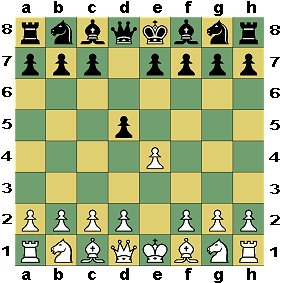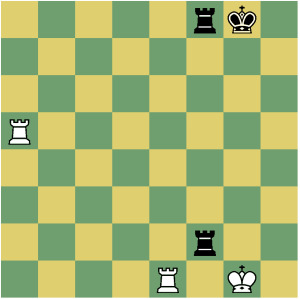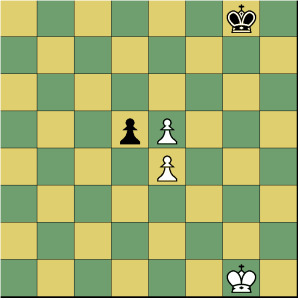In the first part, we saw how the moves of the pawns and pieces are recorded, but we still have to see how captures are recorded, ambiguities are resolved, and some other matters. I haven’t put the labels along the side of the board for all the diagrams in this post. If you need to review how the squares are named, review Chess Notation Part 1.
Recording Captures
It is common to write “x” for “captures.” So if the King captures an enemy piece on f1, the move is written “Kxf1.” (You will find some players and some books that use a colon : to designate a capture. So the King capture described above would be written K:f1. This is not common in the U.S.)
It is common for Pawn captures to name the file that the Pawn is capturing from, and the square that the Pawn is capturing to.

So in the diagram above, if White captures the Black Pawn on the second move, it would be written “exd5.” Some books and players just name the files for Pawn captures. This is an abbreviated notation, and the pawn capture just mentioned would be written simply “ed.”
Removing Ambiguities
If the simple method just described for naming the piece and destination would be ambiguous, you should add the name of a file or rank that would remove the ambiguity. In the diagram below, both White rooks could move to e5.

If the Rook at e1 were to move to e5, the move should be written “Ree5.” If the Rook at a5 were were to move to e5, the move should be written “Rae5.” In that same diagram, both Black Rooks could move to f7. If the Rook at f2 were to move to f7, you should write “R2f7.” If the Rook at f8 were to move to f7, you should write R8f7. Of course, if all else fails, you can remove all ambiguity by naming the piece, the square of origin, and the destination square: Rf8f7.
What about en passant captures?
In the old descriptive notation, en passant captures were written, PxP e.p. (Pawn captures Pawn en passant). In algebraic notation, you would just name the file that the capturing Pawn starts on and the square that the Pawn captures to: exd6. Remember that in the en passant capture, the capturing Pawn arrives at the square that the enemy Pawn bypassed in its two-step move. So though the Pawn being captured may be at d5, the capturing Pawn captures by arriving at d6. In the following diagram, Black has just moved d7-d5.

That means that White has two ways of capturing the d-pawn: each of the White’s e-pawns can make the capture. We can’t just write “ed” (the abbreviated way of writing the move) because this wouldn’t tell us which of the pawns made the capture. But in this case, we can remove the ambiguity by naming the destination square, so our normal way of writing the move will suffice: exd6 would be the en passant capture, and exd5 would be the normal capture. Again, the simple way to remove all ambiguity is to name both the square of origin and the square of destination of the capturing piece: e5xd6 or e4xd5.
How to Record the Castling move, Check, and Checkmate
Castling has a unique designation that doesn’t involve naming any squares. Castling to the king-side (castling “short”) is written 0-0. Castling to the queen-side (castling “long”) is written 0-0-0 (By the way, this is one way in which algebraic notation is the same as English descriptive notation.)
You may see some places where the castling move is recorded differently from the way described above.
Check
If a move ends in check to the enemy King, “+” is added at the end of the move. For example, in the above diagram with the Rooks, White could check the Black King by moving his Rook to g5. This would be written “Rg5+”.
Checkmate
If a move is checkmate, “#” is put at the end of the move (or you could just write “mate” or “checkmate”).
It is also common to write the result of a game using a shorthand. If White wins, this is written “1-0”. If Black wins, the notation is “0-1”. If the game ends as a draw, the notation is “1/2-1/2”.
You can learn all the rules … including chess notation in the wonderful book that I recommend to new players: Learn Chess: A Complete Course. And be sure to see my other posts for the absolute chess beginner.
In Part 3, we will review a short game to test our knowledge of chess notation.

I enjoyed checking out your blog today and I will be back to check it more in the future so please keep up your good quality work. I love the colors that you chose, you are quite talented!
hey theree I just wanted to comment your blog and say that I really enjoyed reading your blog post here. It was very informative and I also digg the way you write! Keep it up and I’ll be back to read more soon mate
Thanks for posting this info.
Awsome! Mst Love Chess
I have copied some text into A word processor.
Aided me a lot, just what I was looking for 😀
Nicely done my friend
i seriously love your writing kind, very exciting, .don’t give up and also keep posting due to the fact it just simply good worth to follow it, .excited to look into a lot more of your current well written articles, enjoy your day